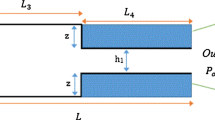Abstract
This paper is devoted to analysing the friction factor for incompressible rarefied gas flow through microchannels. A theoretical investigation is conducted in order to underline the conditions for experimentally evidencing rarefaction effects on the pressure drop. It is demonstrated that for a fixed geometry of the microchannel cross-section, it is possible to calculate the minimum value of the Knudsen number for which the rarefaction effects can be observed experimentally, taking into account the uncertainties related to evaluation of the friction factor.





Similar content being viewed by others
References
Araki T, Kim MS, Iwai H, Suzuki K (2000) An experimental investigation of gaseous flow characteristics in microchannels. Proceedings of the international conference on heat transfer and transport phenomena in microscale, Banff, pp 55–161
Aubert C, Colin S (2001) High-order boundary conditions for gaseous flows in rectangular microducts. Microscale Therm Eng 5:41–54
Beskok A, Karniadakis GE (1999) A model for flows in channels, pipes and ducts at micro and nano scales. Microscale Therm Eng 3:43–77
Beskok A, Karniadakis GE, Trimmer W (1996) Rarefaction and compressibility effects in gas microflows. T ASME J Fluid Eng 118:448–456
Celata GP, Cumo M, Guglielmini M, Zummo G (2002) Experimental investigation of hydraulic and single-phase heat transfer in 0.130 μm capillary tube. Microscale Therm Eng 6:85–97
Ebert WA, Sparrow EM (1965) Slip flow in rectangular and annular ducts. T ASME D J Basic Eng 87:1018–1024
Guo ZY, Wu XB (1997) Compressibility effect on the gas flow and heat transfer in a micro tube. Int J Heat Mass Transf 40:3251–3254
Harley JC, Huang Y, Bau HH, Zemel JN (1995) Gas flow in micro-channels. J Fluid Mech 284:257–274
Kandlikar SG, Grande WJ (2003) Evolution of microchannel flow passages—thermohydraulics performance and fabrication technology. Heat Transf Eng 25:3–17
Li ZX, Du DX, Guo ZY (2000) Characteristics of frictional resistance for gas flow in microtubes. Proceedings of the symposium on energy engineering in the 21st century 2, pp 658–664
Mala GM, Li D (1999) Flow characteristics of water in microtubes. Int J Heat Fluid Flow 20:142–148
Moffat RJ (1988) Describing the uncertainties in experimental results. Exp Therm Fluid Sci 1:3–17
Morini GL (2004) Single-phase convective heat transfer in microchannels: a review of experimental results. Int J Therm Sci 43:631–651
Morini GL, Spiga M (1998) Slip flow in rectangular microtubes. Microscale Therm Eng 2:273–282
Morini GL, Spiga M, Tartarini P (2003) Rarefaction effects in microchannels and friction factor reduction. Proceedings of microscale heat transfer 2 (75th eurotherm seminar), pp 143–145
Saxena SC, Joshi RK (1981) Thermal accommodation and adsorption coefficients of gases. In: Touloukian YS, Ho CY (eds) McGraw-Hill/CINDAS data series on material properties, vols 1–2. McGraw-Hill, New York
Shah RK, London AL (1978) Laminar flow forced convection in ducts. Adv Heat Transf 14:1–477
Sharipov F (2003) Application of the Cercignani-Lampis scattering kernel to calculation of rarefied gas flows. II. Slip and jump coefficients. Eur J Mech B-Fluid 22:133–143
Sreekant AK (1968) Slip flow through long circular tubes. In: Trilling L, Wachman HY (eds) Rarefied gas dynamics. Academic, New York
Wu P, Little WA (1983) Measurement of friction factors for the flow of gases in very fine channels used for microminiature Joule–Thompson refrigerators. Cryogenics 23:273–277
Yu S, Ameel TA (2001) Slip-flow heat transfer in rectangular microchannels. Int J Heat Mass Transf 44:4225–4234
Acknowledgements
This work has been funded through grant I/R/266/02 by ASI (Italian Space Agency) and COFIN 03 by MIUR-URST.
Author information
Authors and Affiliations
Corresponding author
Rights and permissions
About this article
Cite this article
Morini, G.L., Lorenzini, M. & Spiga, M. A criterion for experimental validation of slip-flow models for incompressible rarefied gases through microchannels. Microfluid Nanofluid 1, 190–196 (2005). https://doi.org/10.1007/s10404-004-0028-1
Received:
Accepted:
Published:
Issue Date:
DOI: https://doi.org/10.1007/s10404-004-0028-1




